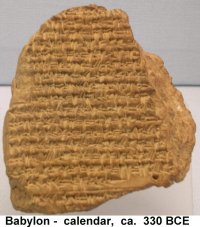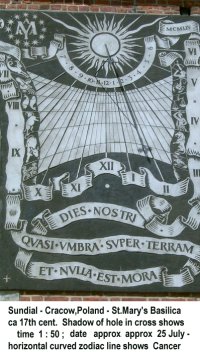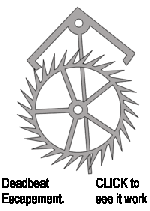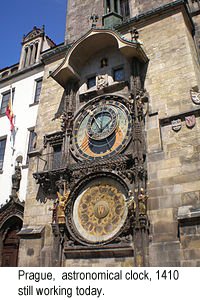

INDEX: Basic units of time.; Ancient calendars.; Julian.; Gregorian.; Hebrew.; Muslim.; Iranian.; Chinese.; Clocks.
Most countries in the world observe a Universal calendar and most of us never think about the origin of this calendar.
As human beings developed an organized life and started to settle down, they realized the need to measure the passage of time.
They observed the changing phases of the moon, the daily movement of the sun. Early clocks and calendars were developed by the Sumerians, the earliest civilization, at least 6,000 years ago.
Only within the last 150 years, we have learned to control the precision of these measurements down to tiny fractions of a second.
The basic unit of time is the day, resulting from the rotation of the earth on its own axis. The length of a day is measured from noon (the sun at its zenith) to noon.
The 23.4 degree tilt of this axis causes changes in the length of day and night during the year, and the seasons, which have significant effect on all living things.
 The tilt, otherwise called the obliquity of the ecliptic, is slowly decreasing at a rate of about 0.04 degree every 1,000 years.
The tilt, otherwise called the obliquity of the ecliptic, is slowly decreasing at a rate of about 0.04 degree every 1,000 years.
The moon orbits the earth, making a full circle every 29.53 days. A month is measured between conjunctions of the moon with the sun, which is when the moon is between the sun and the earth and is therefore totally dark. In most societies the first glimpse of the thin crescent of the new moon, seen just about sunset, has been used as the start of a new month.
The earth orbits the sun. The solar year, also called the
tropical year, is the length of time that the Sun takes to return to the same position in the cycle of seasons, for example, the time from vernal equinox (day and night exactly equal in length) to vernal equinox, which is currently about 365.2424 days (365 days, 14 minutes, 32 seconds).
The orbits of the earth and moon are not circles, but elipses. As a result all the periods (length of day, month, year) are variable with time and method of measurement, but the differences are of the order of a few hundredths of 1%. Huge volumes have been written with many complex formulae to calculate actual precise values.
 As civilizations developed and mankind learned to write and keep records, it became neccesary to develop calendars. However the lengths of the lunar month and the solar year are measured with days and fractions, and have no common denominator.
As a result there are large differences between various calendars prepared over the centuries. This makes comparisons of actual historical dates in ancient times, and between ancient historical records, very difficult. The never ending discussions of when Jesus Christ was actually born are a good example of the problem.
As civilizations developed and mankind learned to write and keep records, it became neccesary to develop calendars. However the lengths of the lunar month and the solar year are measured with days and fractions, and have no common denominator.
As a result there are large differences between various calendars prepared over the centuries. This makes comparisons of actual historical dates in ancient times, and between ancient historical records, very difficult. The never ending discussions of when Jesus Christ was actually born are a good example of the problem.
ABBREVIATIONS: To differentiate between different calendars, the following abbreviations are used:
AH (Anno Higerae) years in the Islamic calendar;
AM (Anno Mundi) years in the Hebrew calendar; AP (Anno Persico) years in the Iranian (Persian) calendar; AUC (Ab Urbe Condita) years in the Roman calendar, starting with the founding of Rome; BCE (Before Common Era) years counting backward from year 1 - also referred to as BC (Before Christ); BP (Before Present) sometimes used when describing very ancient time, where the Present time is 1952; CE (Common Era) years counting from 1 of the present Universal (Gregorian) Calendar - also referred to as AD (Anno Domini); SH (Solar Hijri) years in the current Iranian and Afghan calendars.
If no letters are used, the Common Era is understood.
Return to top of page
Ancient mankind was very concerned with seasons and obvious movements of the sun, moon and stars in the sky. Long before any written history exists. temples were built with obvious astronomical alignments. The best known is
Stonehenge, in England. Constructed over a period of 1,500 years, starting about 5,000 years ago, it consists of circular arrangements of huge stones with an alignment pointing towards sunrise at the winter solstice and sunset at the summer solstice (the shortest and longest days).
However, recent discoveries reveal temples built much earlier in very early agricultural societies, which contain arrangements of large stone pillars - aligned north to south and east to west. The oldest, 11,000 years old at
Göbekli Tepe in south-eastern Turkey.
Another site with pillars aligned toward prominent constellations of stars at the summer solstice, as well as north-south and east-west is at least 7,000 years old
in the Nubian desert south-west of Aswan in Egypt at Nabta Playa
In the Tigris-Euphrates valley (present day Iraq) the Sumerian civilization of city states developed starting around 4,000BCE. By 3,000BCE they had developed a calendar of 12 months of 30 days each and used a sun dial to measure the time of day. The city state of Babylon became the most powerful and had astronomers and mathematicians who developed the 60-base system for measuring angles in circles and subdividing the day which is what we still use today. In the Babylonian calendar each month started when the crescent moon was observed at sunset. Periodically an extra month was inserted to keep the months in line with the actual solar seasons. Days started at sunset and were divided into 12 equal parts (two of our present hours).
During the same period in the Nile valley the Egyptian civilization developed. In Luxor astronomers developed a 365 day year starting with the coincidence of the rise of the sun and the star Sirius. The Nile floods start at the same time. They established 12 30-day months, with one month 5 days longer. They divided the day into 12 hours and developed elaborate sun dials for measuring time during the day and water clocks to measure the time at night. At the early
A civilization was developing at the same time in the Indus valley, There are records of trade between the Sumerian city states and the Harrapan states around 2,000 BCE. It vanished about 500BCE. Little is known about their calendar except that they used lunar months.
On the American continent, the earliest writing appears in the
Olmec civilization south of Vera Cruz, Mexico, about 600BCE. However the earliest calendar discovered so far is that of the Maya. It was based on three cycles of days and the solar year with no use of the lunar month. The
Aztec calendar is similar but has two cycles - 365 day solar cycle, consisting of 18 months of 20 days plus five extra ünlucky" days; and a 260 day tonalpohualli day count. An elaborate scheme linked the two cycles together.
Return to top of page
In ancient Rome the calendar was borrowed from the Greeks; the year was 304 days with 10 lunar months. During the reign of king Numa Pompilius about 713BCE, the calendar was revised to 12 approximately lunar months, varying from 28 to 31 days. In order to keep the calendar year roughly aligned with the solar year, a leap month was added from time to time at the end of February. The highest priest (Pontifex Maximus) decided when an intercalary month was to be inserted. However this rule was not followed regularly, so by the year 46BCE, the calendar year was out of step with the solar year and seasons by three months. Julius Ceasar decreed a calendar revision.
At the first full moon after the winter solstice, 1 January 45BCE, the new
Julian calendar came into effect.
It has 12 months, with alternating 31 and 30 days, except February has 28 days, thus the year is 365 days long compared with the solar (tropical) year of 365.24. Every fourth year is a leap year with 29 days in February. Thus the average year of the four year cycle is 365.25 days. This calendar was used by most of the civilized world until the 16th. century. The begining of the counting of years kept changing. Originally the founding of the state of Rome AUC (Ab Urbe Condita) was used, 21 April 753 BCE. At other times the start of a reign of a Roman ruler was used.
The numbering of the years to start with 1 AD (now called the Common Era in the Universal calendar) was introduced by a monk Dionysius Exiguus. He was working in the Vatican in the early 6th century to translate and organize documents. He was given the assignment to devise the correct way of calculating the date of Easter. Incorrectly he calculated the year of birth of Jesus Christ as AUC 753 to use as the starting date for the new calendar. At that time the concept 0 (zero) was unknown, so the year before 1 AD was 1 BC (Before Christ). The new calendar soon became universally accepted throughout the Christian world.
Return to top of page
The solar year is 365.2425 days, and the Julian calendar has an average year of 365.25 days, so there is an error of 0.75 of a day every 100 years. Over 13 centuries the error accumulated to become 10 days,
 the Vernal Equinox was on March 11 instead of the proper date March 21. Pope Gregory XIII was very disturbed because the important Christian holiday of Easter was not occurring on the Sunday after the first full moon after the true Equinox.
the Vernal Equinox was on March 11 instead of the proper date March 21. Pope Gregory XIII was very disturbed because the important Christian holiday of Easter was not occurring on the Sunday after the first full moon after the true Equinox.
The Pope signed a decree establishing a new calendar in which Leap Year (which is in any year divisible by 4) was dropped in any year divisible by 100, except when divisible by 400. Also 10 days were dropped - October 4, 1582 was followed by October 15, 1582 - to bring the calendar back into synchronism with the solar cycle. The new calendar is so accurate that it will require 3,322 years for a one day error to result. Therefore it has been adopted by all nations, except Saudi Arabia and Iran, as the Universal Calendar.
The change was introduced by a Catholic Pope, all Catholic countries accepted it very quickly. Protestant countries were reluctant. Prussia and Netherlands switched in 1700. England and its colonies (including North America) adopted it in 1752. Eastern European countries which belong to the Eastern Orthodox church continued to resist change. Russia switched in 1918, Greece in 1923. Japan accepted the Gregorian calendar in 1873, Korea in 1895, China in 1912.
However, the Eastern Orthodox churches in eastern Europe still use the Julian calendar for their church services and feasts. So, forexample, in 2013 they celebrated Christmas on 7 January 2014, and of course
Easter is usually on a different date than in all the other Christian churches.
Return to top of page
The Hebrew calendar is the official calendar of Israel and the liturgical calendar of the Jewish faith. It was written by the patriach Hilliel II in the middle of the 4th century CE, based on rules that had developed over several hundred years since the Jews' exile to Babylon in the 6th century BCE.
It is a lunisolar calendar. The calendar year features twelve lunar months of twenty-nine or thirty days, with an intercalary lunar month added periodically to synchronize the twelve lunar cycles with the longer solar year. It is added seven times during a nineteen year cycle.
Hebrew days begin at sunset, The beginning of each Jewish lunar month is based on the appearance of the new moon. The first month of the year starts with the first sighting of the new moon at sunset after the Vernal Equinox, the beginning of Passover.
However the start of the calculated year is at the start of the seventh month, with the High Holidays of Rosh Hashanah and Yom Kippur. The first year in the Hebrew calendar celebrates the creation of Adam and Eve, supposedly 3760 BCE. Therefore the year 2013 in the Universal calendar is the year AM5773 in the Hebrew calendar, which started 12 September 2012.
Return to top of page
The Arabic world used a lunar calendar with alternating 29 and 30 days, with an extra month, called Nasi' being added periodically to keep the lunar and solar calendars in alignment. However the Qu'ran in Sura 9:36-37, which reads in part "The number of months with Allah has been twelve months by Allah's ordinance since the day He created the heavens and the earth...". As a result the use of the extra month Nasi' was deemed to be forbidden.
Therefore, the Islamic calendar is 11 days shorter than the solar calendar, and all Islamic feasts and holy days occur 10 or 11 days earlier each year. The beginning of the Islamic calendar, called the Hijri calendar, is the day of Muhammad's arrival in Medina, set as Friday, 16 July 622 of the Julian calendar, 33 Hijri years equal 32 solar years. The year 2013 of the Universal calendar is AH1434.
The Hijri calenda is the official calendar of Saudi Arabia. Almost all other Muslim countries, for practical reasons, use the Universal calendar, reserving the Hijri calendar only for determining religious holidays.
Return to top of page
The Persian calendar is basically a solar calendar that dates back to the second millenium BCE, or over four thousand years before present time. It starts at the Vernal Equinox. Originally it was based on the Babylonian calendar and used 12 months of 30 days each, and every 6th year an additional 30 day month was added to keep it in synchronism with the seasons. Over time modifications were added.
The present Iranian Solar Hijri calendar has six consecutive 31 day months, followed by five 30 day months and one month which is 29 days. Every four years the last month has 30 days. Every 28 years a correction is made by adding an extra year in the cycle - that is the leap year is shifted from the 4th to the 5th year, Then the 4 yesr cycle starts again. This keeps the Iranian calendar in step with the solar year., thus maintaining synchronization with the Solar year. The year starts at the Vernal Equinox, the feast of Nowruz. The years are numbered starting with the Prophets arrival in Medina in 622 of the Julian calendar. Accordingly the current Universal year 2013 is year SH1392.
The Solar Hijri calendar is the official calendar of Iran and Afghanistan.
The Chinese calendar is complex and now only used for cultural and religious purposes. China adopted the Universal calendar for general and administrative use in 1912.
The beginnings of the Chinese calendar can be traced back over 4,000 years. Legend has it that the Emperor Huangdi invented the calendar in 2637 BCE.
The Chinese calendar is complex and based on exact astronomical observations of the longitude of the sun and the phases of the moon and is divided into cycles of 60 years, each subdivided into groups of 12 years each with a name of a creature. A year in the Chinese calendar begins on the second new moon after the winter solstice, unless an intercalary month moves it to the third new moon.
The current year (February 10, 2013 to January 30, 2014) is Chinese year 4711 and the year of the Snake.
Return to top of page
In early societies people observed the changing position of the sun during the day, and of the moon and stars at night and adjusted their activities accordingly. Sundials and water clocks were developed by Babylonians and Egyptians, and as the designs were
 improved , by 1,500BCE they were subdividing the arcs of the dials into 6, then 12 hours, and eventually also into fractions of hours. Hipparchus, a Greek mathematician and astronomer (190 BC - 120BC), proposed dividing the day equally into 24 hours which came to be known as equinoctial hours.
improved , by 1,500BCE they were subdividing the arcs of the dials into 6, then 12 hours, and eventually also into fractions of hours. Hipparchus, a Greek mathematician and astronomer (190 BC - 120BC), proposed dividing the day equally into 24 hours which came to be known as equinoctial hours.
The Greeks built some complex water clocks (klepsydra) with the capability to subdivide the hour into smaller fractions. The development of an escapement between 1348 and 1364 in Padua by Giovanni de' Dondi, a professor of astronomy at the university, introduced the era of mechanical clocks. The escapement provided fixed steps which allowed dividing time into much shorter intervals with increased accuracy. Systems of weights and pendulums were used as the driving force. A 99cm (39 inch) long pendulum has a natural frequency of about 2 seconds (each swing 1 second). Therefore the Babylonian hexagesimal system was used to divide hours into 60 minutes, minutes into 60 seconds.
One of the first major clocks using an escapement was in Salisbury cathedral, England. Installed in 1386, it had no face, being designed only to strike the hours. The original mechanism is still working today! The clock in the cathedral of Wells, built in 1392, strikes the quarters and also possesses a dial showing the movement of astronomical bodies. These earliest mechanical clocks used foliots, a horizontal rod with adjustable weights, to adjust the frequency of oscillation.
 The invention of the pendulum by Galileo in 1602, and its introduction into a clock in 1656 by the Dutch scientist Christiaan Huygens, simplified the design of clocks and greatly increased their accuracy to a few seconds per day. By the end of the 17th. century, grandfather clocks with pendulums were being introduced into wealthier homes all over Europe.
The invention of the pendulum by Galileo in 1602, and its introduction into a clock in 1656 by the Dutch scientist Christiaan Huygens, simplified the design of clocks and greatly increased their accuracy to a few seconds per day. By the end of the 17th. century, grandfather clocks with pendulums were being introduced into wealthier homes all over Europe.
The invention, and later refinement, of a spring driven escapement made smaller clocks and later pocket watches possible. By 1768, the English watchmaker Thomas Mudge had perfected small clocks and watches that only needed rewinding every 8 days.
The British navy desperately needed an extremely accurate timepiece in order to be able to determine longitude and thus improve navigation. In 1714, the British government offered a prize for a method of determining longitude at sea, with the awards ranging from £10,000 to £20,000 (several million dollarss in modern terms). After many years of intensive work. John Harrison presented model H4 of his marine chronometer, which passed the required test of sailing to Barbados and back with an error of only 39 seconds over several months. Subsequent improvements by other clock-makers, including John Arnold, reduced the cost so that eventually every ship carried a marine chronometer, whose accuracy was not surpassed
until the invention of electronics and quartz oscillators in the 20th century.
Toward the end of the 20th. century, atomic clocks were developed, that measured time based on electro-magnetic radiation of cesium atoms at very low temperature. This resulted in the development of a Standard Second. All other time intervals are now multiples of this second. However, as the rotation of the earth slows down, about every two years an extra second has to be added to the time signals transmitted from national Standard Laboratories, to keep Universal Standard Time in synchronization with solar time.
As local time is derived from the moment that the sun reaches its zenith, time was different in every location. As long as travel was slow, and it took several days to travel between major cities, this was of no consequence. With the invention of railroads, and then the telegraph and telephone, different times became confusing, establishing railroad timetables very difficult. For examples in Russia, to this day, railroads run on Moscow time, with train time out of synch with the local standard time by several hours in Siberia.
In 1884, at a conference in Washington, the zero (zulu in military useage) meridian was established at Greenwich, England, and Greenwich Mean Time (GMT) was adopted as the world time standard. Time meridians 15° apart are also one hour apart in time. From this the Time Zones developed and had become universally adopted by 1925. Greenwich was chosen because the royal observatory at Greenwich was renowned for its accurate clocks and for developing astronomical tables used by ships of all nations.
Universal Standard Time (UT) uses a 24 hour clock, hours-minutes-seconds, midnight being 00:00:00. The international standard ISO 8601 sets the universal way to write dates: YYYY-MM-DD-HH-MI-SS, for example 2013-03-25-13-04-05 means 2013-March-25-13(in US useage 1pm)hours-4 minutes-5 seconds. Of course, the time is not included when just writing dates.
Return to top of page.
Go to history index for many articles about history and national customs.
All illustrations are courtesy of Wikipedia.org under Creative Commons Attribution-Share Alike 3.0 Unported license.
History of civilizations
easy comparison of the progress of mankind in time and space.
Spring time celebrations around the world.
Ancient calendars and clocks from ancient to modern.
Clocks, their history and theory.
Calendars, a detailed history of calendars and astronomical calculations
Time zones around the world.
Easter , all about Easter.
